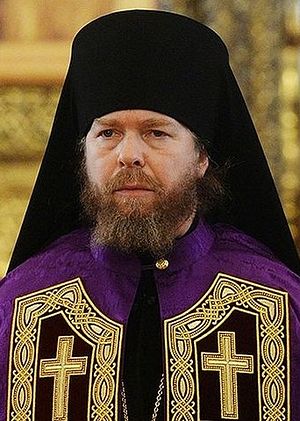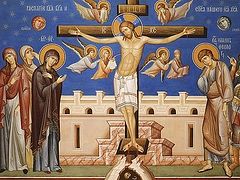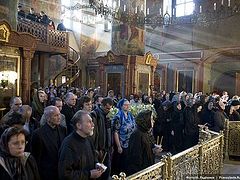On Sunday evening, Bishop Tikhon (Shevkunov) of Egorievsk gave a homily at the first “Bridegroom” service of Holy Week. We cite here an excerpt that touches upon the parable of the fig tree.
I thank all of you who have gathered here in the church to begin Holy Week, to follow Christ in the final days of His earthly sojourn, Golgotha, and finally His Bright Resurrection. Every day of the Passion has its own profound significance. All of us who read the Gospels know about these days, but the Holy Church now emphasizes them in particular to us. When the Lord walked with His disciples He said to them, “Now we are going into Jerusalem, and the Son of Man shall be betrayed into the hands of men.” Now with clear minds let us go with Him, be crucified with Him, to renounce earthly joys for His sake, so that we might rise with Him and hear His voice saying, I ascend unto my Father, and your Father; and to my God, and your God (Jn. 20:17). And I shall take you with me not to the earthly Jerusalem, but to the Jerusalem on high.
Today we recall how when, as Jesus walked with His disciples, He warned them of one of the most difficult temptations of Christian life: fruitlessness. And along their path was a beautiful, green, blossoming fig tree. The tree was adorned with many leaves. The Savior approached the tree, hungered, as it says in the Gospel. Despite the fact that it was spring He was expecting fruit. We ask, what fruits could there be in spring? Trees bear fruit in autumn. Now here is an interesting fact: First of all, there are usually fruits still hanging on a fig tree from autumn. Furthermore, in the Holy Land fig trees bear fruit twice a year—in spring and late autumn. And there are usually fruits left from autumn that remain almost until spring. But the Savior did not find any fruits—not early fruits, nor late fruits. And using this image He points out another very important sign to His disciples. Before being mocked, humiliated and crucified by the people, he showed that His divine authority along with him, at His word—the word of God the Word Who did not find there any fruit, which He had sought even from a tree—the fig tree immediately withers, as the Evangelist writes. Right before their eyes. And the apostles saw that despite the Savior’s anxiety—and He was worried as He walked to Jerusalem, as He told his disciples, His foretelling of the suffering that He would soon have to undergo—He voluntarily goes to meet the only path that would lead Him to His divine Father, and the entire human race to salvation.
This image of fruitlessness amidst abundant garments of leaves must always remain with us. We can outwardly look like anyone we want—bishops, priests, pious laypeople, but the Lord is looking for inner fruits, spiritual fruits: love, joy, peace, longsuffering, meekness, temperance. The apostle writes about these fruits. St. John the Forerunner also called people to fruits of repentance.
Very special hymns will be sung in church these first few days of Holy Week: “Behold, the Bridegroom comes at midnight, and blessed is that servant whom He shall find watching…” And similar to this hymn, we shall hear, “I see Thy bridal chamber adorned, O my Savior, and I have no wedding garment that I may enter there. Make the robes of my soul to shine, O giver of life, and save me.” The Holy Scripture of the Old and New Testaments, and the holy fathers in explaining the scriptures, often describe the soul as a bride, preparing herself to go and meet her Bridegroom. It is the house prepared for the bride, the soul. This is what this hymn is about. And also, our Bridegroom is coming at midnight.
These are two hymns about our soul, and about the Lord Jesus Christ—that is the meaning of these hymns.





